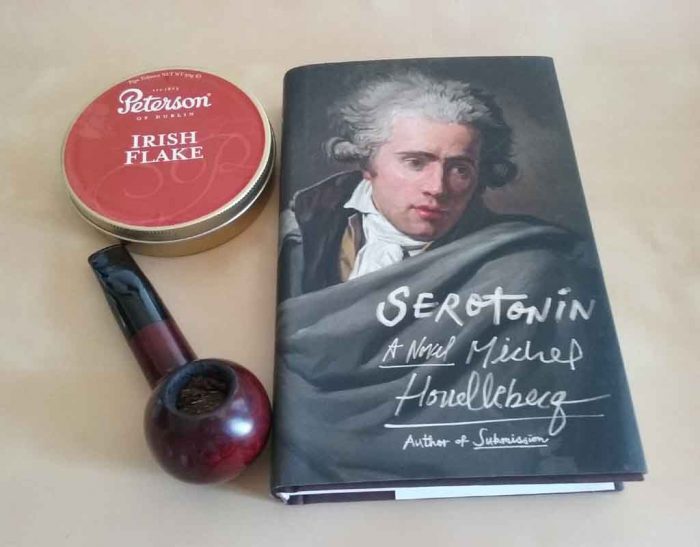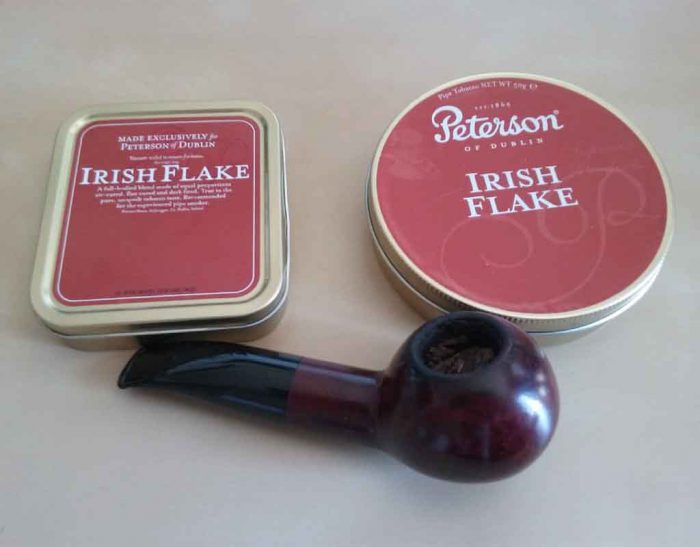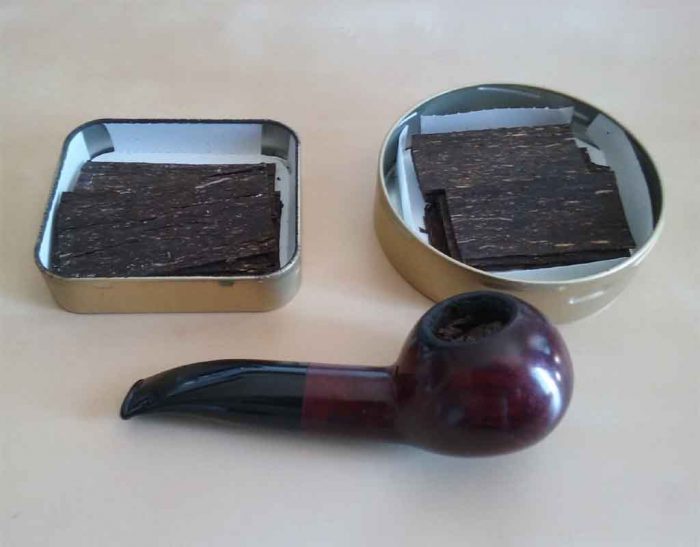People generally split into two groups: those who want an external order so that they can focus on their inner refinement, and those who want no external order so that they can avoid self-actualization. The former like tradition, where the latter detest it, and claim the former just repeat the past out of fear of the new.
When it comes to pipe tobacco blends, we see the same division. Some constantly quest for the “new,” while others look for the best of the old and cellar as much of it as they can. With blends around today that vary from two centuries to two weeks of history, there are plenty of options.
Irish Flake appealed to those who like the subgenre of old-school UK flakes. These tend to use stronger smoke-cured leaf alongside Virginias, hot-pressing the two to crush the cells in the tobacco leaves and release many of the chemicals that impede nicotine absorption. These flakes tend to be strong and flavorful, but not excessively sweet. Instead, their Virginia trademark sweetness emerges from within a richer and varied flavor.
Peterson — made by Scandinavian Tobacco Group (STG) — has been re-tooling its blends of late. They had to rename Irish Oak to Irish Cask because new EU rules disfavor tobacco which names a plant but does not contain or taste like that plant, or at least this is what pipe lore holds.
Taking advantage of the upheaval, Peterson/STG has made some intelligent changes. They dropped the amount of mixed-berry flavoring on University Flake, for example, and may have reduced the amount of rum and honey topping on Irish Cask. Both of these are intelligent moves, if proven to be true.
On the other hand, they also changed Irish Flake. The new flake is shorter, incorporates more bright Virginia, and instead of the old anise-heavy topping, favors the same mixed-berry madness that anoints University Flake. Mixed with the rich flavors of dark-fired Kentucky Burley used in the flake and anise, this produces a berry-and-cola style flavor, much like the soft drink “Dr Pepper,” which with the sweetness of the new blend of Virginias, makes this an entirely different flake.
Much as the new Royal Yacht favors Lane 1-Q over its old Empire topping, the new Irish Flake leaves behind the UK flake formula in favor of something more like Orlik Old Dark Fired, a sweet soft flake which leads the market (along with Orlik Golden Slice) because it is, well, sweet and easy to smoke.
In contrast, the longer flakes of the old Irish Flake have a darker flavor that more emphasizes natural tobacco with an anise overlay, and those require a bit more effort to smoke and enjoy. The new Irish Flake is quite good for what it is, and quite good as a flake, but it has lost something of tradition and of the intensity of those older-style flakes.
Those of us who enjoy UK plugs and flakes tend to do so for the same reason that we enjoy English blends with Latakia: the UK tended to take different things, combine them into something new, and then refine them into a flavor that on the surface was gnarled and off-putting, but underneath, complex enough to enjoy smoking all day long.
While most people think they want sweet, mild, and smooth blends to smoke all day (the elusive “all-day” smoke that industry pursues in a time when most people cannot smoke all day, or anything like it, because workplaces are hostile to smokers) the blends to which we return tend to be the idiosyncratic and challenging ones because one can pop these little flakes in the pipe contentedly, knowing that no smoke is quite like the others.
In the same way that Capstan Original Navy Cut delights with its shifting mixture of bright and orange Virginias, Irish Flake buried a wide range of flavors within the outer shell of smoked leaf. Now, that is no more. One wishes that Peterson/STG had merely forked off the new flake instead of adulterating the old.
Tags: irish flake, peterson, pipe tobacco, scandinavian tobacco group, tobacco





pipe tobacco reviews are fucking gay. kill yourself after yuo suck Styxhexenhammer666’s cock
He seems like a nice fellow, and I’m glad he’s wearing shirts now, but isn’t he a lolbert?
The narrator of Seratonin indicates no reunion with Camille yet he relates knowledge of the conception of her child that could only be attained through an intimate conversation. Does this suggest a secret post-script happy ending or is Houellebecq just getting sloppy?
It’s an anomalous passage. My guess is that the implication is as you suggest: he found out after the narrative events concluded, but before the narrative was written. One can hope.
Smoking is degenerate behavior
and your comment isnt
thanks :)
:|
Houellebecq is a bitch that projects all his internalized insecurities into writing. They are all weaklings that fear death!
P.S. smokers stench of ashtray.
nothing like crumbling the butts to roll that last one, especially if you havent smoked since the morning and eaten since yesterday
The only contemporary novelists I’ve enjoyed were McCarthy & DeLillo and I guess I’m too prole for Pynchon & DFW.
What’s a good starting point for Houellebecq?
atomized
“I’m too prole for Pynchon”
Try Bleeding Edge. Captures what people like about Pynchon, but isn’t as endlessly self-indulgent.
Vinland is also very close to the average Gibson novel, and we should perhaps mention Pattern Recognition as quality late postmodernism here.
I enjoy much of what DeLillo writes, and agree with the commenter above who recommended Atomized/The Elementary Particles as an introduction to Houellebecq.
Hi Brett, I noticed in ‘dm.org/metal/best_of’, ‘In The Nightside Eclipse’ is in the death metal list, is that a mistake or on purpose? What do you think is the difference between black metal and death metal?
I always think that black metal is close to the ambient, them creating a space where your mind can roaming in there, usually with repeating the same riff and drumbeats, but still have somekind of black metal like Emperor, more ‘instrumental’ more ‘band’ creative techniques, not just ‘scene’ music. Maybe I didn’t express myself well, is it just like somekind of Burzum(94/96) is the *pure* black metal? And many other bands usually are just black metal style in death/heavy/speed metal?
If someone say ‘Anthems To The Welkin At Dusk’ is not black metal, I’ll identify with him easily, but ‘In The Nightside Eclipse’ make me a little confused.
Have there been articles on this topic? How to define black metal more academically.
HEY BRETT EVEN THOUGH BLACK METAL HAS BEEN AROUND SINCE THE 80s AND THERE’S NO SHORTAGE OF STUFF TO HEAR AND RESEARCH ON MY OWN, CAN YOU PLEASE DEFINE BLACK METAL FOR ME?
DID YOU PUT EMPEROR IN THE DEATH METAL LIST BY ACCIDENT? I THINK U PROBABLY DID, BUT I YOU DIDN’T CAN YOU PLEASE TELL ME WHY SO I CAN RATIONALIZE HAVING THE SAME OPINION FROM NOW BECAUSE YOU THINK IT? PLEASE RESPOND
Of course av8d know what is the difference between dm & bm, I just want to get a new enlightening rofessional perspective on this.
That’s got to be a data entry glitch, one I’ve probably been meaning to fix for years.
You have the basics right. Death metal is more structure-based, where black metal incorporates melody, and is more atmospheric as a result.
At this point, later Emperor just sounds like guitar practice to me.
There’s more organized information (hopefully) in the Heavy Metal FAQ.